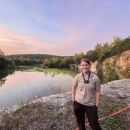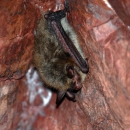UPDATES:
(March 25, 2025)
NO formal update to the Survey Guidelines Document for 2025
Surveyors should follow the most recent version of the bat survey guidelines (i.e., 2024 Version) for planning presence/probable absence surveys. That document, as well as several other related documents, remain available below.
Proposed Acoustic Surveys for 2025- review updated approved software list (before submitting study plan)
The Survey Guidance Team tested SonoBat and a new version of Kaleidoscope Pro and have updated the list of approved software on the Automated Acoustic Bat ID Software Programs page. Before submitting your study plan, please review the list of approved software programs and all associated footnotes if you are conducting acoustic presence/probable absence surveys in 2025.
Background:
The Indiana bat (Myotis sodalis) was originally listed as endangered under the Endangered Species Preservation Act of 1966 (32 FR 4001, March 11, 1967), and continues to be listed as endangered under the Endangered Species Act (ESA) of 1973, as amended. In 2015, the U.S. Fish and Wildlife Service (Service) listed the northern long-eared bat (Myotis septentrionalis) as threatened under the ESA and in 2022 the Service reclassified the northern long-eared bat as an endangered species. This survey protocol provides the Service's recommended guidance on survey methods and outlines additional reporting requirements for surveyors for Indiana bat and northern long-eared bat.
Range-wide Indiana Bat/Northern long-eared bat Survey Guidelines:
- Current Survey Guidelines Document
- Current Survey Guidelines FAQ
- Study Plan Form (revised March 25, 2025)
- Previous Survey Guidelines FAQ versions
- Automated Acoustic Bat ID Software Programs
- Methods to Establish Recommended Minimum Summer Survey Effort: White Papers










